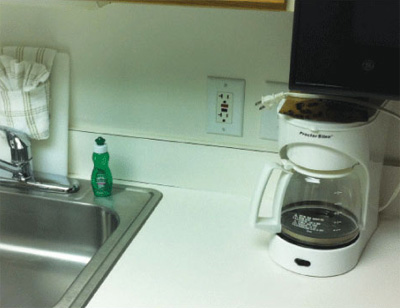
It’s eight o’clock at night and you find yourself standing in front of energized equipment because you were called about an unplanned inspection and they needed it done right away. You realize you are going to be in and around energized equipment. It’s late. You didn’t plan on being here, and what is being asked of you seems to be quite simple. For whatever reason, the situation has you a little apprehensive about the task at hand and you would feel more comfortable with the right safety equipment. In the back of your mind you know you should be wearing your personal protection equipment (PPE). So the dilemma plays out. Looking back at your work truck, you realize your PPE isn’t there; it’s back at the office, which is a hike. You just want to spend the evening with your family and really don’t want the aggravation and time it is going to take to dress up for what will probably be uneventful. It may be that little guy in your head or someone there with you, either way there’s a voice telling you, “Just get this job done and let’s get out of here.”
If your PPE were readily accessible, a lot of hesitation would be removed from the above equation and, more than likely, you would have completed this job with the appropriate gear. Well, at least you wouldn’t have an excuse.
If that one doesn’t resonate, put yourself in the shoes of the homeowner who has to perform the required testing of AFCI, GFCI and other safety devices in the home. A quick walk around the house to each room is in order to locate those GFCI receptacles to test. Your trip to the load center where AFCIs and GFCIs can be found is your planned last stop, but not before you get to the garage. So you walk into the garage and locate that GFCI receptacle behind those large metal shelving units that you installed soon after you got into the home a few years ago. It didn’t take long to pack all of your tools and boxes on all of those shelves, but it will take an effort to clear enough of them out to get to that GFCI receptacle. Just over on the next wall, you can’t see it but you know it’s there, you have another GFCI receptacle behind that cool 1950s refrigerator that holds the beer. As you contemplate the effort it’s going to take to clear an access path and move that heavy refrigerator, you can’t help but think about all of those other GFCIs that you tested and the fact that they all tested good. As you close the garage door you tell yourself these last two devices are “probably” OK. But then again, you realize that every time you do this it’s the same story. You basically have never tested those devices.
Readily Accessible Defined
Whether it be safety equipment you should be wearing or those push buttons on GFCI receptacles installed in homes, readily accessible is important for safety. Quite appropriately so, accessible related definitions in the National Electrical Code are the first three definitions presented in Article 100. When it comes to accessible, the NEC has the following definitions:
Accessible (As applied to equipment). Admitting close approach; not guarded by locked doors, elevation, or other effective means.
Accessible (as applied to wiring methods). Capable of being removed or exposed without damaging the building structure or finish or not permanently closed in by the structure or finish of the building.
Accessible, Readily (Readily Accessible). Capable of being reached quickly for operation, renewal, or inspections without requiring those to whom ready access is requisite to climb over or remove obstacles or to resort to portable ladders, and so forth.
For some, when mentioning readily accessible with respect to the code, the first thought that comes to mind is GFCIs. Section 210.8, “Ground-Fault Circuit-Interrupter Protection for Personnel” of the NEC specifically calls out the requirement that the GFCI shall be installed in a readily accessible location. This accessibility is important to facilitate the testing of these devices through exercising their push to test and reset buttons. It applies to both GFCI receptacles and GFCI circuit breakers. This helps ensure that the device is working properly. A Leviton instruction sheet for a GFCI receptacle advises on the proper procedure and frequency for testing a GFCI receptacle as follows:
“Procedure:
“(a) This GFCI is shipped from the factory in the tripped condition and cannot be reset until the Line and Load are wired correctly and power is supplied to the device. Plug a lamp or radio into the GFCI (and leave it plugged in). Turn the power ON at the service panel. Ensure that the GFCI is still in the tripped condition by pressing the TEST button. If the lamp or radio is ON go to the Troubleshooting section because LINE and LOAD wiring connections have been reversed.
“(b) Press the TEST button in order to trip the device. This should stop the flow of electricity, making the lamp or radio turn OFF. Note that the RESET button will pop out. If the power stays ON, go to Troubleshooting. If the power goes OFF, you have installed the GFCI receptacle correctly. To restore power, press the RESET button.
“(c) If you installed your GFCI using step 7B, plug a lamp or radio into surrounding receptacles to see which one(s), in addition to the GFCI, lost power when you pressed the TEST button. DO NOT plug life saving devices into any of the receptacles that lost power. Place a “GFCI Protected” sticker on every receptacle that lost power.
“(d) Press the TEST button (then RESET button) every month to assure proper operation.”
As this Leviton instruction leaflet advises, you must press the test button and then reset button every month to assure proper operation. These devices are more likely to be tested when they are readily accessible. That can be quite a challenge more so for a receptacle than a circuit breaker as often times receptacles meet the language of the code up until the moment the homeowner moves in and decides to place furniture or other items in front of them. You may have felt the frustration of trying to find that GFCI receptacle that tripped or have helped a homeowner do the same only to find that the receptacle was hidden behind a piece of furniture or other obstruction. A little education to homeowners can go a long way to helping them avoid these issues and help them understand the importance of testing these devices.
Not Just a Test Button Requirement

Photo 1. Typical GFCI usage on a kitchen counter
Readily accessible is important for a few different reasons. In one aspect it is a means to provide access for testing and inspection as in the case of GFCI receptacles. Another is its ability to facilitate correct behavior. A good example of the latter can be found in Section 210.60, “Guest Rooms, Guest Suites, Dormitories, and Similar Occupancies” of the NEC. This section talks about receptacle placement as part of Section 210.60(B) advising that “At least two receptacle outlets shall be readily accessible.” Readily accessible outlets help to prevent a homeowner from stringing extension cords around the room. Extension cords are not supposed to be permanently installed but can be found implemented in that manner in many older homes where an inadequate number of receptacles is, unfortunately, a reality. Just as in the first example in the opening paragraph of this article, having access to what you need when you need it facilitates correct behavior.
The NEC works to also make certain electrical items are not readily accessible to ensure safety. In the examples and discussions so far we have demonstrated why it is important to have access to electrical devices such as GFCIs as they require our direct interaction and use to receive the safety benefits. But of course there are those things that we should not interact with to ensure our safety. A great example of this can be found in Section 230.24, “Clearances.” Article 230 focuses on services and the desire here is to ensure service-entrance cables are not able to be easily reached. Putting electrical items out of reach is a good way to help prevent inadvertent contact with energized conductors that could result in death. This section of theNECworks to ensure that these conductors are not readily accessible by stating, “Overhead service conductors shall not be readily accessible.” Section 230.24 even describes exact measurements that help you understand what is considered readily accessible and what is not when it comes to these service-entrance cables for different locations including the roof and other locations.
The NEC also includes the use of this term with respect to the disconnecting means for electrical equipment such as motors. These disconnecting means must be in readily accessible locations. In some cases, the switches must also be in line of sight of the equipment they operate. Still other instances require proper labeling as well. There is no denying that readily accessible is important to safety. These two words will continue to be important to the NEC.
NEC-2014 Proposals
Yes, we are indeed in the middle of the next revision to the NEC and panel members cannot escape the proposals around readily accessible. A requirement of being readily accessible can present some challenging situations. Panel two debated Michael Johnston’s, National Electrical Contractors Association (NECA), proposal 2-52 and the other similar proposals. The panel accepted proposal 2-52 that addresses the issue of those roof top areas that are typically locked to ensure un-authorized individuals do not have access. The GFCI devices on that roof are required, as per Section 210.8(B)(3), to be readily accessible. Those buildings that have access through doors that are required to be locked for safety do not leave the GFCI devices in a readily accessible location. The same goes for those structures that do not have permanent ladders affixed to the outside of the building. The accepted proposal adds an exception to the rule stating “Receptacles on rooftops shall not be required to be readily accessible other than from the rooftop.”
Arc-Fault Circuit Interrupters (AFCIs) as required in 210.12(A) and (B) are not immune to this requirement. The submitter’s substantiation in proposal 2-116 that was Accepted in Principle identified that “With now the option of a listed outlet branch-circuit type arc-fault circuit-interrupter receptacle the possibility of this receptacle being placed in a location that could place it in a not readily accessible location could exist.”
The growth of the use of readily accessible is inevitable as we find more and more instances of safety equipment such as GFCIs that must be tested on a periodic basis that are not in readily accessible locations. There are some proposers out there that would like to see all equipment that requires periodic testing in accordance with its listing instructions installed in readily accessible locations. This passion will drive more and more language in theNEC.
As always, keep safety at the top of your list and ensure you and those around you live to see another day. If you have any tips or ideas you would like to share, please feel free to send them to me at thomasadomitrovich@eaton.com. I look forward to your input to these articles and guidance for future articles.














Find Us on Socials